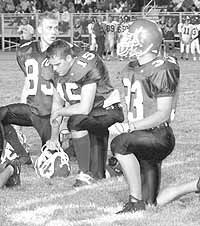In a recent youth risk behavior survey, it was found that athletes were less likely to use illicit drugs. The findings and conclusions of this report were derived from analysis of the nationally representative survey of over 16,000 public and private high school students in grades nine through 12, developed by the Centers for Disease Control and Prevention. It was concluded that playing sports was associated with reduced risk for illicit drug use.
This study provides an objective assessment of the relationship between sports and adolescent health. American teenagers today encounter a wide range of potential health risks, and the choices they make can determine not only their health and well-being, but their very survival as well. Athletic participation is ordinarily seen by athletes, coaches, parents, and other interested parties as a route to good health and social success.
Some specific findings documented by this study are listed below. All comparisons are made within genders, that is, they are made between athletes and nonathletes of the same gender with some comparisons between the subgroup of highly involved athletes and nonathletes.
•Athletes were less likely to use illicit drugs.
Playing sports was associated with reduced risk for illicit ddrug use. Both male and female athletes were less likely than nonathletes to use marijuana, cocaine, and other drugs, such as LSD, heroin or speed.
•Findings on anabolic steroids were mixed.
Male athletes overall were no more likely to use anabolic steroids than male nonathletes were. However, female athletes overall, and highly involved male athletes, were both nearly one and a half times more likely than their nonathletic counterparts to use steroids, and highly involved female athletes were nearly twice as likely to do so. However, only about two percent of teenage girls used anabolic steroids overall.
•Only highly involved athletes were more likely to binge drink.
Contrary to popular belief, neither female nor male athletes were significantly more likely than nonathletes to drink alcohol overall, or to drink in excess. However, highly involved athletes of both genders were somewhat more likely to binge drink than nonathletes.
•Athletes were less likely to smoke cigarettes, but more likely to use chewing and dipping tobacco.
Athletes were less likely than nonathletes ever to have smoked cigarettes regularly or to have smoked within the past month. However, both male and female athletes were more likely to use chewing/dipping tobacco. In fact, highly involved female athletes were more than three times as likely to do so as female nonathletes. Only about two percent of teenage girls used chewing/dipping tobacco overall.
•Athletes were less likely to be suicidal.
Both female and male athletes were less likely than their nonathletic counterparts to seriously consider or make a plan for committing suicide. Male athletes were also less likely than male nonathletes to actually attempt suicide. However, highly involved athletes of both genders who do attempt suicide were nearly twice as likely as suicidal nonathletes to require medical treatment as a result.
•Female athletes had more positive body images, but were more likely to attempt weight loss.
Both female and male athletes were less likely than nonathletes to describe themselves as overweight. However, female athletes were more likely to try to lose weight, and though they were more likely than nonathletes to use dieting and exercise to do so, highly involved female athletes were also more likely to use vomiting and/or laxatives to lose weight.
•Female athletes were more likely to wear seatbelts, but more likely to drive after drinking.
Findings regarding the relationship between athletic participation and vehicular risk were mixed. Female athletes were a third more likely than nonathletes to wear seatbelts.
Female athletes overall, and highly involved athletes of both genders, were also more likely to drive an automobile after drinking than nonathletes.
Our results show that athletic participation has both positive and negative implications for adolescent health in America today. In order to guide athletes, coaches, parents, and communities to better use sports as a means of promoting adolescent health, a list of policy recommendations follows.
•The Women’s Sports Foundation developed the following policy recommendations in order to promote the health of adolescent athletes, especially girls. Given the widespread interest and involvement of American teenagers, high school and community sports are appropriate social settings in which to plan and implement community health interventions.
A panel of leaders from education, government, public health, women’s health organizations, and sports was created to review the findings from this study and to identify policy goals.
Some of the goals which were identified to promote adolescent health through sports include the following.
•Create federal, state, and local policy and action agendas to support athletics.
Educators and local, state, and federal policy officials need to evaluate the status of high school and community sports in their domains. Many school districts are experiencing the erosion of high school sports programs, a dwindling of public resources, and a decrease in athletic opportunities.
In particular, poorer neighborhoods often lack the resources to support local teams. Therefore, it is recommended that these areas create a national policy for the protection and enhancement of high school and community sports in the U.S.
Both public and private funds should be provided to promote health advocacy through sports.
•Use sports as a gateway to adolescent wellness and long-term health promotion.
Families, educators, parent-teacher associations, community organizations, and health professionals must evaluate and monitor the extent to which athletic programs protect and promote the health of teen athletes. Furthermore, the lifestyle choices and health, habits that teenage athletes adopt affect their health later in life, promising not only better quality of life but significant savings in health care costs
•Proponents of adolescent health should develop health-related educational materials specifically for athletes.
•Public health departments should emphasize sport as an avenue to good health.
Youth involved in athletics less likely to engage in risky habits

